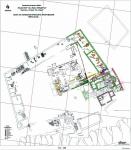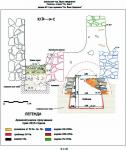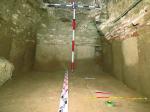Summary (English)
ST. JOHN PRODROMOS MONASTERY (Kazimir Popkonstantinov, Rossina Kostova – korina68bg@yahoo.com, Milen Nikolov) Room No. 1 was explored in the eastern wing of the monastery dated to the 15th – 17th centuries and adjoining the eastern surrounding wall. The room measured 15 m by 5.50 m and was built over the debris of the earliest basilica. Room No. 2, 6 m by 5.50 m in size, and Room No. 3, 7.50 m by 5.50 m in size, were explored to the north of Room No. 1. The finds from the rooms included bricks, roof-tiles, sun-dried bricks, sherds of the 16th – 17th centuries, including from sgraffito pottery, faience of the Iznik Type, iron nails, clamps, plates from doors, keys and a candle snuffer. Sherds of the 5th – 6th centuries AD and two Latin coins of the 14th – 15th centuries were found in the layers beneath the rooms. An Early Christian barrel-vaulted tomb was explored, situated close to the northern foundations of the Prothesis of the earliest basilica. The tomb was 2.37 m by 1.39 m in size, built of bricks and stones bonded with mortar, oriented east – west. The foundations of the tomb were built of vertically arranged tegulae. The floor was paved with four layers of horizontal tegulae. Two parallel bodies were discovered in the tomb, buried at 50 cm from each other and oriented to the west. The dead were men, the first one 50 – 60 years old and 1.70 m high and the second one 45 – 50 years old and 1.75 m high. The tomb was partly destroyed by earthquake. A skeleton of a sheep three years old, oriented to the east was discovered in the tomb, rested some time after the destruction. The calibrated radiocarbon date of the sheep skeleton is end of the 6th – first quarter of the 7th centuries AD. A bronze coin of Justinian I minted in AD 538 – 565 that fell in the tomb after its partial destruction was also found. A bronze chain from icon lamp, glass fragments from windows, cups and icon lamps, fragments from roof-tiles and sherds of the 5th – 6th centuries AD were found in the embankment around the tomb. Layers of debris from buildings of the 5th – 4th centuries BC were documented in the profiles.
- Kazimir Popkonstantinov - Department of Archaeology, Veliko Tarnovo University St. Cyril and St. Methodius
- Milen Nikolov - Regional Museum – Burgas
Director
- Rossina Kostova - Department of Archaeology, Veliko Tarnovo University St. Cyril and St. Methodius
Team
Research Body
- Veliko Tarnovo University St. Cyril and St. Methodius






![Download [PDF]](/excavation/skins/fasti/images/results/download_sml.png)

